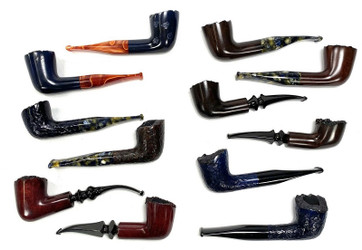Whether you’re completely new to the world of pipes or you’ve only tried one type so far, it's crucial to determine which type of tobacco pipe is best suited to your needs. How do Corn Cob Pipes and Briar Pipes compare? In what situations might one type be better than the other? In today's short guide, Paykoc Pipes' expert smoke shop team explores the differences and similarities between briar pipes and corn cob pipes.
Corn Cob Pipes and Briars: The Basic Facts
History: Corn cob pipes have been around for over 150 years so they’re not a new invention by any stretch of the imagination. While they don’t have quite the same pedigree as wooden pipes, which can be traced back to the beginning of the 17th century, they have an established history and are loved by many pipe smokers across the globe.
Cost: The most notable difference between a corn cob pipe and a briar pipe is how much they cost. A good briar will cost upwards of $35, and can cost as much as several hundred dollars. A corn cob pipe, on the other hand, can be had for just a few dollars.
Looks: The next thing you’ll notice when browsing our selection of corn cob pipes is their aesthetic. Even the best made ones will look a little rustic next to a highly polished briar pipe. This isn’t necessarily a bad thing: while you probably won’t want to pull out a corn cob pipe at a formal dinner party, they are perfect for casual gatherings, fishing trips and any other occasion when functionality is more important than form. That’s not to say they are unattractive – many people love the look of a traditional cob pipe – it’s just that they are more down-to-earth than their briar cousins.
Durability: The cheapest cob pipes are not the most durable of pipes: they can last for a year or two with careful handling but the bottom of the bowl (the cob) tends to fail eventually. This isn’t a real issue as far as most pipe smokers are concerned because you can pick up half a dozen corn cob pipes for the price of a decent briar. You can also find cob pipes with hardwood inserts in the bottom of the bowl, which solves this problem.
The Draw: The stems on corn cob pipes normally have a considerably larger bore than those of briar pipes, providing a wide-open draw when you pull on them. This makes them a great choice for beginners as even if you pack your tobacco too tightly, you’ll probably still enjoy a decent smoke with a cob pipe.
Moisture absorbency: Briar is beloved by pipe aficionados because it is great at absorbing the moisture in tobacco that is released as it heats up. However, when possible, it is recommended to rest a briar pipe for a day in between smokes, to allow it to dry out. Corn cob pipes, on the other hand, are known for their ability to take plenty of abuse: they can be used multiple times a day without getting too moist. If you take it to the extreme and find that the tobacco in your cob pipe keeps going out, you can simply leave it out in the sun for a few hours to dry.
Corn Cob Pipes vs. Briar Pipes: When Is One Better Than the Other?
Now you know the basic differences, it’s time to consider when one might be a better choice than the other.
Gifts: If you have friends who have shown an interest in trying a pipe, a corn cob pipe is an easily affordable gift that you can give them. Buying a briar for someone who may or may not continue to use a pipe is possibly a little wasteful.
Camping and Fishing Trips: As mentioned earlier, the rustic look of a corn cob pipe is perfect for outdoor activities like fishing and camping but there are other reasons they make the perfect traveling partner. A cob pipe will perform well in windy conditions and if the bowl gets a little burnt it doesn’t really matter. If you take a prized briar pipe instead and the outside of the bowl becomes blackened in windy conditions, you might not be so happy. And with the low cost of corn cob pipes, you won’t lose much sleep if you accidentally drop one in the river when you’re fishing.
Taste: This is more of a subjective factor but many pipe smokers like the cool, dry smoke they get from a corn cob pipe. It makes them suitable for a wide variety of tobaccos – from aromatics to straight Virginias. Some say they do not really suit a full-flavored English blend but the best way to find out whether you prefer the flavor of a particular blend in a cob or briar pipe is to try it for yourself.
Corn Cob Pipes vs. Briar Pipes: Final Thoughts
If you’re about to try pipes for the first time, a corn cob pipe is a good choice. They perform well in most weather conditions and they’re easy to clean. They’re also inexpensive so you won’t have to spend much to find out whether pipe smoking is really for you. However, if you know you’re in it for the long haul and you’re planning to smoke a pipe at formal gatherings or you want to try the heavier English blends, a briar could be your best option.

 US Dollars
US Dollars
